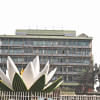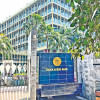Reserves remain under pressure

Pressure on the foreign exchange reserves remains high as the deficit in the financial account continues to widen despite the narrowing trade gap and a current account surplus.
At the end of October, the deficit in the financial account stood at $3.96 billion, in contrast to $1.27 billion a year earlier, as per the latest data from Bangladesh Bank.
The financial account is the component of the country's balance of payments that cover claims or liabilities to non-residents concerning financial assets. Its components include foreign direct investment, medium and long-term loans, trade credit, net aid flows, portfolio investment and reserve assets.
Typically, a deficit in the financial account means more investments are flying out of the country than coming in and is a major factor behind the running down of foreign exchange reserves.
At the end of October, the country's gross reserves stood at around $20.6 billion, down from $27.5 billion a year earlier.
The country's dollar stockpile has shrunk further: as of November 29, which is the latest published data by the BB, reserves stood at $19.40 billion.
Forex reserves would not decrease further in December because more than one billion dollars are expected from the International Monetary Fund and the Asian Development Bank, BB Spokesman Md Mezbaul Haque told journalists yesterday.
Besides, the central bank is aiming to keep the reserves at a stable position until the national election scheduled for January 7 next year, according to central bank officials who spoke on the condition of anonymity to reveal internal discussions.
The fund from the IMF and the ADB would create some breathing space but the pressure point on the BoP will remain high, said Zahid Hussain, a former lead economist of the World Bank's Dhaka office.
The pressure point remains high because of the outflow of trade credit, which has trebled from the previous year, he said.
Trade credit is the difference between export shipments and export receipts.
In the first four months of the fiscal year, the deficit in trade credit was $3.65 billion. A year earlier, it was $1.32 billion, according to data from the BB.
Exporters are unwilling to bring in their export proceeds before the polls, according to BB officials.
Another reason for the deficit in financial account is the drop in short-term foreign debt by the private sector, Hussain said.
At the end of October, there was an outflow of $898 million in net short-term foreign debt, in contrast to inflows amounting to $1.04 billion a year earlier.
"Now, the option of taking on short-term foreign loans is no longer available even though there is an appetite for it in the private sector."
At the beginning of the year, total outstanding short-term foreign debt was $16.4 billion. Ten months later, it stood at $12.13 billion.
Between July and October, the trade gap declined 60.4 percent year-on-year to $3.8 billion as imports dropped 20.5 percent and exports ticked up 3.6 percent.
During the period, the current account balance was $233 million in surplus, in contrast to a deficit of $4.48 billion a year earlier.
However, the current account surplus is of no solace: it contracted by $877 million in October alone.
"Export growth slowed and remittance inflows are also drying up. So the current account surplus has narrowed from the previous month. The challenges on the external balance remain high and that is why the pressure on reserve lingers," Hussain added.


 For all latest news, follow The Daily Star's Google News channel.
For all latest news, follow The Daily Star's Google News channel. 








Comments